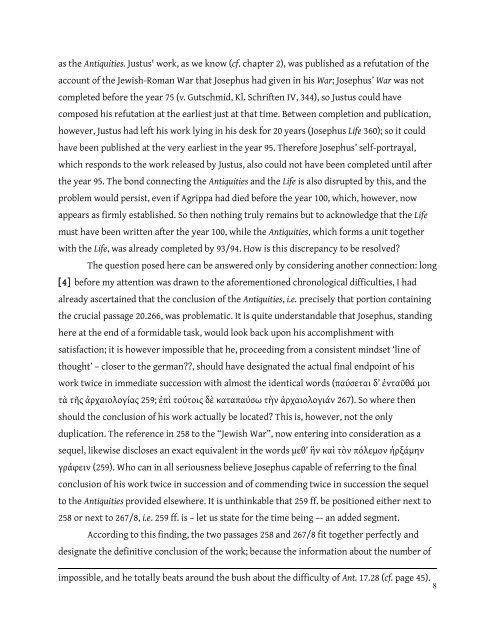The Jewish Historian Flavius Josephus: A Biographical Investigation
The Jewish Historian Flavius Josephus: A Biographical Investigation
The Jewish Historian Flavius Josephus: A Biographical Investigation
Create successful ePaper yourself
Turn your PDF publications into a flip-book with our unique Google optimized e-Paper software.
as the Antiquities. Justus' work, as we know (cf. chapter 2), was published as a refutation of the<br />
account of the <strong>Jewish</strong>-Roman War that <strong>Josephus</strong> had given in his War; <strong>Josephus</strong>’ War was not<br />
completed before the year 75 (v. Gutschmid, Kl. Schriften IV, 344), so Justus could have<br />
composed his refutation at the earliest just at that time. Between completion and publication,<br />
however, Justus had left his work lying in his desk for 20 years (<strong>Josephus</strong> Life 360); so it could<br />
have been published at the very earliest in the year 95. <strong>The</strong>refore <strong>Josephus</strong>’ self-portrayal,<br />
which responds to the work released by Justus, also could not have been completed until after<br />
the year 95. <strong>The</strong> bond connecting the Antiquities and the Life is also disrupted by this, and the<br />
problem would persist, even if Agrippa had died before the year 100, which, however, now<br />
appears as firmly established. So then nothing truly remains but to acknowledge that the Life<br />
must have been written after the year 100, while the Antiquities, which forms a unit together<br />
with the Life, was already completed by 93/94. How is this discrepancy to be resolved?<br />
<strong>The</strong> question posed here can be answered only by considering another connection: long<br />
[4] before my attention was drawn to the aforementioned chronological difficulties, I had<br />
already ascertained that the conclusion of the Antiquities, i.e. precisely that portion containing<br />
the crucial passage 20.266, was problematic. It is quite understandable that <strong>Josephus</strong>, standing<br />
here at the end of a formidable task, would look back upon his accomplishment with<br />
satisfaction; it is however impossible that he, proceeding from a consistent mindset ‘line of<br />
thought’ – closer to the german??, should have designated the actual final endpoint of his<br />
work twice in immediate succession with almost the identical words (παύσεται δ’ ἐνταῦθά μοι<br />
τὰ τῆς ἀρχαιολογίας 259; ἐπὶ τούτοις δὲ καταπαύσω τὴν ἀρχαιολογιάν 267). So where then<br />
should the conclusion of his work actually be located? This is, however, not the only<br />
duplication. <strong>The</strong> reference in 258 to the “<strong>Jewish</strong> War”, now entering into consideration as a<br />
sequel, likewise discloses an exact equivalent in the words μεθ’ ἣν καὶ τὸν πόλεμον ἠρξάμην<br />
γράφειν (259). Who can in all seriousness believe <strong>Josephus</strong> capable of referring to the final<br />
conclusion of his work twice in succession and of commending twice in succession the sequel<br />
to the Antiquities provided elsewhere. It is unthinkable that 259 ff. be positioned either next to<br />
258 or next to 267/8, i.e. 259 ff. is – let us state for the time being –- an added segment.<br />
According to this finding, the two passages 258 and 267/8 fit together perfectly and<br />
designate the definitive conclusion of the work; because the information about the number of<br />
impossible, and he totally beats around the bush about the difficulty of Ant. 17.28 (cf. page 45).<br />
8
















